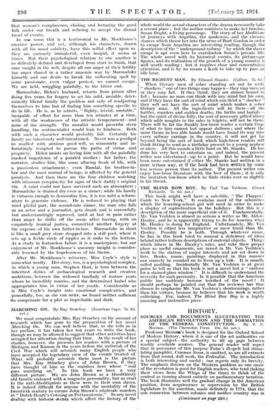We must congratulate Mrs. Ray Strachey on the amount of
-research which has gone to the preparation of her novel Marching On. We can well believe that, as she tells us in her preface, it has taken her ten years to write the book, though we may be allowed to suggest that other activities have occupied her attention during that time. As the result of her studies, however, she presents her readers with a picture of Michigan and Kansas in the years before the outbreak of the Civil War which will astonish many English people, who have accepted the legendary view of the events treated-of. What will probably astonish them most is the picture that Mrs. Ray Strachey gives of John Brown, if they have thought of him as the stainless hero whose " soul goes marching on." In this book we have a very different picture. We see John Brown as a bloodthirsty old fanatic endowed with a magnetic personality, but as cruel to the anti-Abolitionists as these were to their own slaves. It is indeed difficult for anyone with the mentality of the twentieth century to excuse John Brown's wholesale murders at " Dutch Henry's Cressing on Pottawatomie." In any novel -dealing with historie cheats which affect the history of the
whole world the actual characters of the drama necessarily take a second place ; but the author contrives to make her heroine, Susan Bright, a living personage. The story of her Abolition- ist journeys with Angelina, the quakeress, and the circum- stances which throw her into the arnis of Burt Gordon in order to escape from Angelina are interesting reading, though the description of the " underground railway " by which the slaves escape is apt even here to overshadow Susan's priVate life; The whole novel with its historical events, its picturesque figures, and its realization of the growth of a young country is well worth reading ; but it requires close and concentrated attention, and is by no means a book to take tip to pass an idle hour.










































 Previous page
Previous page